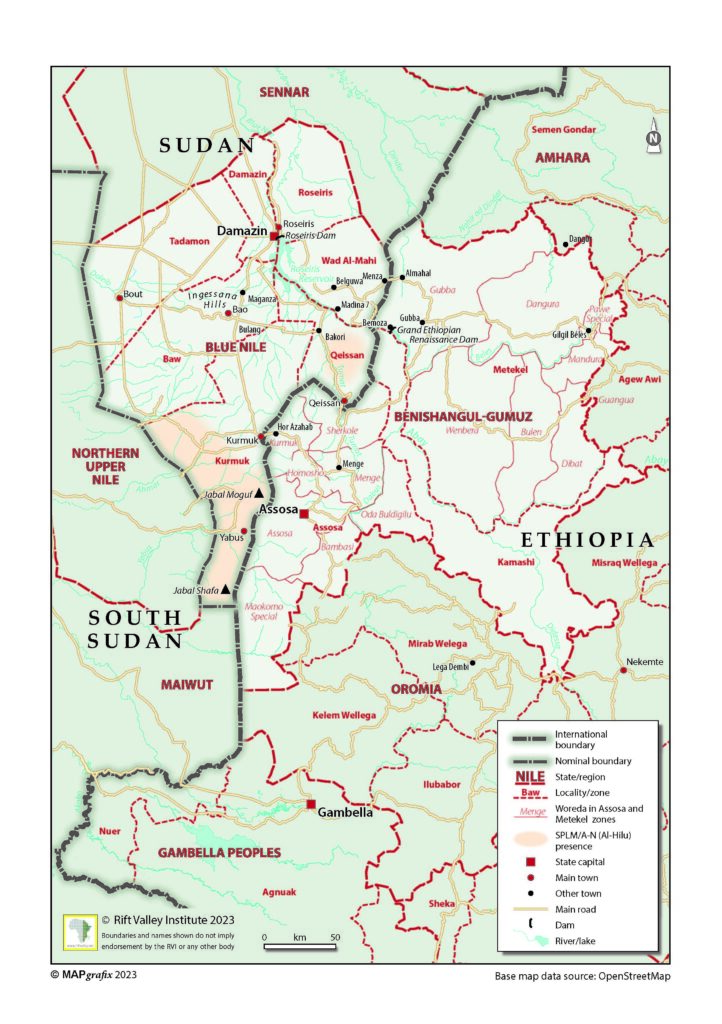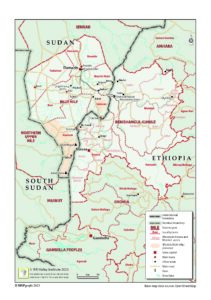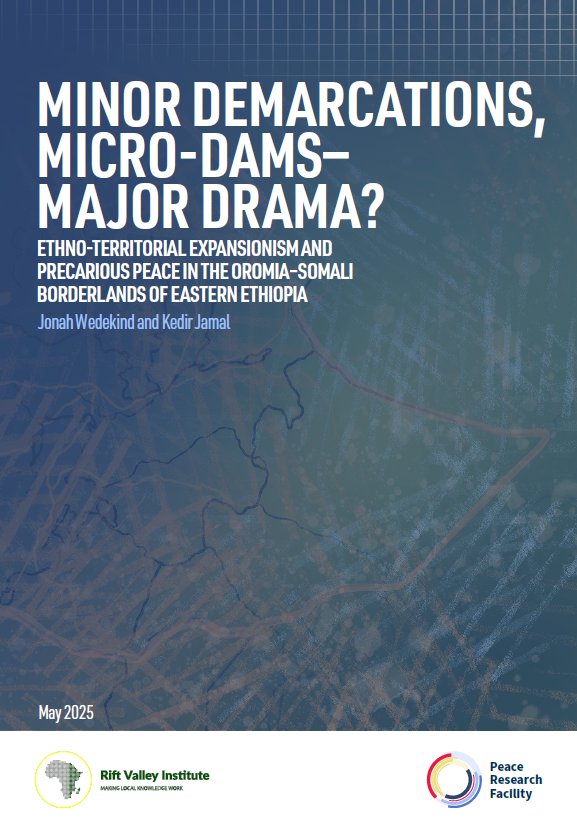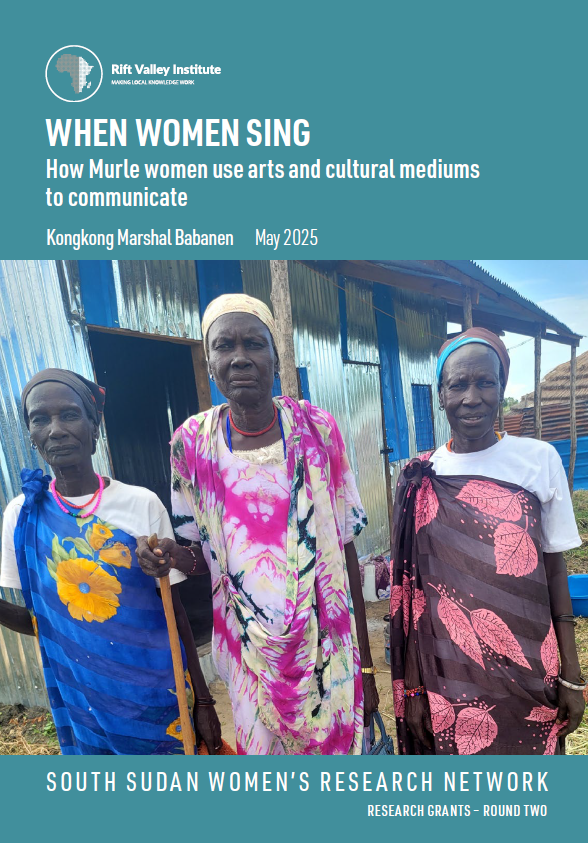Armed opposition groups in Sudan and Ethiopia’s border regions have a history of leveraging support, often military, from their neighbours to aid their political aspirations at home. These dynamics have fluctuated in line with broader changes in the region and geopolitically, but rebel groups are used to waiting, and take their opportunities when they emerge. This blog is a product of the XCEPT (Cross-Border Conflict Evidence, Policy and Trends) research programme. It is part of a wider research project on the Blue Nile – Benishangul-Gumuz border region. Read the full report here.

The border between Blue Nile state in Sudan and Benishangul-Gumuz region in Ethiopia snakes north to south, separating the two countries and imperfectly dividing communities on either side of it. In Ethiopia, it is one part of what is sometimes referred to as the country’s ‘Western Frontier’ – a geographical area that is far from the centre of political and economic power in Addis Ababa and other major regional capitals. In Sudan, the east of the country has historically been the site of political opposition and armed insurgency, which has grown out of the region’s marginalization from the centre of power in Khartoum. However, despite their geographical remoteness, Blue Nile and Benishangul-Gumuz are also both strategically important to their national governments. First, they are the location of major hydroelectric and agricultural projects manifested in the construction of enormous dams on the Blue Nile: the Roseires dam in Blue Nile state itself, and the Grand Ethiopian Renaissance Dam (GERD) in Benishangul-Gumuz. Yet, despite the importance attached to these projects, for the people living in these regions they are characterized much more by their marginalization than their strategic centrality or political importance. On both sides of the border, this has resulted in different groups taking up arms against their own governments, often seeking support from neighbouring governments looking for opportunities to destabilize rival regional powers. This is the second reason why these border regions have become strategically important – they are places where regional actors have been able to clandestinely project power and where security must be closely managed.
Blue Nile’s rebels bide their time
In the 1980s and 90s the Sudan People’s Liberation Movement/Army (SPLM/A) sought, and acquired, support from Ethiopian governments in their long-running war against the regime in Khartoum, including allowing the group to operate from territory within Ethiopia. Ethiopian support was critical to the SPLM/A’s operations. However, shifts in regional politics – particularly the 1998-2000 Ethio-Eritrea border war – resulted in a scaling down of Addis’s support for the SPLM amidst fears that Khartoum might decide to back Eritrea.
The 2005 Comprehensive Peace Agreement (CPA) brought an end to the SPLM/A’s war with Khartoum, thus removing a major source of potential leverage for Ethiopia over its neighbour. However, after South Sudan’s secession from Sudan in 2011, the rump of the SPLM/A that remained in Blue Nile and South Kordofan states – known as the SPLM-North – which also had its own, distinct, local grievances, restarted the war against the government. This time, however, the SPLM-N lacked significant support from its neighbours – a major reason why the insurgency effectively ground to a halt by 2016. Subsequently, the movement engaged in a bitter internal dispute, then split. One faction of the SPLM-N in Blue Nile – under the leadership of Malik Agar – signed the Juba Peace Agreement (JPA) with the post-Bashir Khartoum government in 2020. The other SPLM-N faction, under the leadership of Abdelaziz al-Hilu, refused to join the peace process and retains control of significant territory in Blue Nile and South Kordofan states. The SPLM-N is now a less significant factor in relations between Sudan and Ethiopia than in previous decades.
Benishangul insurgents cash in their advantage
On the other side of the border, in Benishangul-Gumuz, the Gumuz and Benishangul communities have sought support from successive regimes in Khartoum to reverse their perceived political marginalization. These struggles continue and remain an active dynamic in relations between Khartoum and Addis. In fact, recent shifts in relations between Sudan, Ethiopia and, crucially Egypt, which sees the GERD as a threat to its control over the Nile, has given groups on Ethiopia’s western borders greater salience – a tool that can be used as leverage over the government in Addis Ababa.
In practical terms, this meant that the armed opposition group, the Benishangul People’s Liberation Movement (BPLM), received military support from the Sudanese government, via the Sudan Armed Forces (SAF), since 2020, which played a role in the uptick in their insurgency in Benishangul-Gumuz, albeit not a decisive one. In fact, the support that Khartoum, and perhaps Egypt, have channelled to the BPLM did little more than help sustain a relatively small rebellion, rather than enable the group to succeed in achieving more ambitious goals. In late 2022, the BPLM signed an agreement with the regional administration in Assosa, and in early 2023 commenced a negotiation over political and security arrangements.
The rebellions in Benishangul-Gumuz are not just sustained by external support, but are a product of the complex local, and regional politics of Ethiopia, particularly issues related to land, ethnic federalism and how different groups living in the region interact, particularly so-called indigenous and settler communities. These local conflicts – as was the case in Blue Nile state too – can often be instrumentalized, or become bound up with bigger, geopolitical battles, for example the desire to control the headwaters of the Nile, with external support often escalating local conflict dynamics.
Other conflicts along the border
In Ethiopia, Benishangul-Gumuz is by no means the only location where this is the case. For example, Sudan has also provided support – again, relatively limited – for the Tigray People’s Liberation Front (TPLF) in its war with the federal government. Tigrayan forces have operated from areas in eastern Sudan, and despite the signing of the Pretoria Agreement in November 2022, and the generally successful implementation of the Agreement since then, thousands of Tigrayan soldiers remain in Gedaref in Sudan – leverage for Khartoum against Addis Ababa, and also Asmara. Sudan and Eritrea fell out during the Tigray conflict as Asmara grew upset at Khartoum’s support for the TPLF and lack of support for Prime Minister Abiy’s government. Sudan’s government, and especially the Sudan Armed Forces, are wary of the Ethiopian-Eritrean rapprochement since 2018, fearing they could unite against Sudan, and have since looked for ways to divide their relationship and weaken both countries.
Other regions on Ethiopia’s western border, particularly Gambella, have also been drawn into a similar pattern of local political struggles being influenced, and sometimes accentuated by, regional or geopolitical influence. In Gambella, there is evidence that some Murle groups, who also live in South Sudan, have been supplied with arms and ammunition (probably by Egypt via the Sudan Armed Forces) likely as a means to create trouble – albeit fairly limited – in a region that the federal government has struggled to effectively manage. Ethiopia appears to have responded by creating an Anyuak proxy force in the same region – a familiar method of outsourcing security responsibilities to local militias. Whilst the problem may never develop to a scale that would cause real concern to either Ethiopia or South Sudan, it may continue as a running source of irritation, or distraction, and also a potential demonstration that Ethiopia’s enemies have the ability to cause problems in these areas if they wanted to, as well as increased local conflict.
Playing the long game
The end of the TPLF’s war against the federal government, militias from the Amhara region and the Eritrean military, has also influenced the course of the rebellions in Benishangul-Gumuz and other areas. The apparent vulnerability of the government in Addis Ababa had spurred on Ethiopia’s other rebels (some with support from the TPLF) to redouble their efforts. However, with the TPLF’s rebellion now seemingly over, and Ethiopia seeing a remaking of political alliances at the national level, groups inhabiting the ‘Western Frontier’ may decide to bide their time, or cash in their political credit in the hope of some limited gains (as has happened in Benishangul-Gumuz). However, others may choose to bide their time, happy to play the long game and see what the future holds. This is also evident in Sudan, where the SPLM-N in Blue Nile is waiting for the outcome of Sudan’s political transition to see if a new government with significant civilian political power materializes before deciding how it might approach a future peace process.



